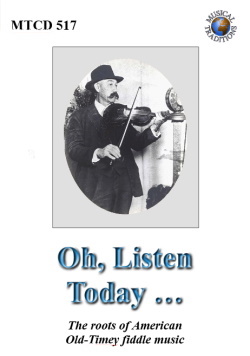
The roots of American Old-Timey fiddle music
Musical Traditions Records - MTCD517

1. Flop-Eared Mule - The Highlanders. 2. Humphrey's Jig - Ed Haley. 3. Jenny Baker - Jimmy Johnson's String Band. 4. Waynesburgh - Fiddlin' Doc Roberts. 5. Charleston No.3 - Narmour & Smith. 6. Too Young to Marry - The North Carolina Ramblers. 7. Devil's Dream - Jasper Bisbee. 8. Buck Creek Gal - Fiddlin' Doc Roberts. 9. Grey Eagle - Ed Haley. 10. Billy in the Low Ground - Cuje Bertram. 11. Fisher's Hornpipe - Emmett Lundy. 12. Booth - Marcus Martin. 13. Fire in the Mountain - The Red-Headed Fiddlers. 14. Sally Brown Jig - Allen Sisson. 15. Black-Eyed Susie - Nester & Edmonds. 16. Wilson's Jig - Ed Haley. 17. Salt River - Kessinger Brothers. 18. Natchez Under the Hill - Emmett Lundy 19. Grandad's Favorite - Ernie Carpenter. 20. Queen of the Earth and Child of the Skies - Edden Hammons. 21. Polka Four - Kessinger Brothers. 22. Wake Up Susan - Ed Haley. 23. Jenny on the Railroad - Carter Brothers & Son. 24. Seneca Square Dance - Fiddlin' Sam Long. 25. Indian Ate the Woodchuck - Ed Haley. 26. Lady Hamilton - Manco Sneed. 27. Scolding Wife - Marion Reece. 28. Old Flannigan - The Blue Ridge Mountaineers. 29. Cumberland Gap - Manco Sneed. 30. The Old Clay Pipe - The North Carolina Ramblers.Compiler Mike Yates's booklet notes, with their background description, annotated tracklisting and biographical data for each of the artists, are available elsewhere on this website, so there's no need for a reviewer to cover the same ground in much detail. Moreover, the companion volume, A Distant Land to Roam, Anglo-American songs and tunes from Texas to Maine, Musical Traditions Records MTCD516, has already been reviewed here. That compilation comprised 1920s and '30s recordings, by Old Timey singers in the US, of songs and ballads originating in the British Isles. For variety, it also included a few tunes of which the same story could be told. The present volume takes that further, consisting entirely of instrumental tunes of a similar pedigree.
The process of moving from one continent to another, and of being passed down the generations, tended to result in new tune titles which reflected American place names (like Charleston, Salt River, or Natchez), or referred to American personalities (like Waynesburgh and Booth), or just had a more New World ring to them, like Jenny On The Raiload or Buck Creek Gal. Flop Eared Mule is another such, although the tune's origins seem to lie elsewhere in Europe; the notes point to versions in Estonia, the Ukraine and Scandinavia. Its enduring popularity has resulted in any number of US versions, as well as Jimmy Shand's recording under the title Bluebell Polka.
Most tunes, though, have a British isles connection, in some cases a very clear one (e.g. 'Jenny Baker' = 'The Boys of Blue Hill', or 'Devil's Dream' = 'De'il Amang the Tailors'). In other tunes, the connection can be, to a greater or lesser extent, less obvious, but phrases such as 'a faint suggestion' or 'may be related to' only add to the interest, and encourage closer listening (as the title of the collection suggests). There's further intrigue in the notes about Indian Ate the Woodchuck which pose, but don't presume to resolve, questions about two-way tune exchange. Any absence of definitive answers is all part of the attraction, and no reflection on the thoroughness of the notes, which are a pleasure to read. Who wants every detail on a plate, anyway? I might be struggling a wee bit to hear a connection between Seneca Square Dance and What Shall We Do With the Drunken Sailor, but it's a lot of fun trying.
78s are the source of most of the content, although we also have field recordings, including one as late as 1970, Cuje Bertram's thrilling Billy In The Low Ground, complete with fractious infants in the background. Most are dance tunes, an exception being Edden Hammons's beautiful slow air, Queen of the Earth and Child of the Skies, which the notes suggest is related to the Irish tune The Blackbird. This raises a further interesting consideration, as another American tune based on The Blackbird is The Wounded Hoosier, which might or might not have some distant connection to the Irish Wounded Hussar (thanks to Roly Brown for making this tentative suggestion following my review earlier this year of Hog-Eyed Man 4 which includes the former tune). The music goes round and round and it comes out here, as the philosopher once said.
The performances have evidently been picked as much for their musical merits as for their thematic function, and singling out individual tracks for comment generally seems unnecessary. The sheer brilliance of this music still has the power to captivate, whether from the 78 era, or the rich the legacy of field recordings, and this selection offers enormous pleasure and satisfaction, quite apart from the other aspects of interest.
Ray Templeton - 28.12.19
| Top | Home Page | MT Records | Articles | Reviews | News | Editorial | Map |